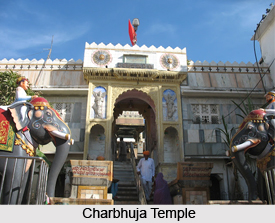 Pilgrimage tourism in Rajsamand district is a truly divine and enchanting experience. There are a number of very beautiful temples located here, each with their own story to tell. Most of the temples here date back to ancient times, right back to the times of the Mughal rule in India. The foundation of the temple of Shrinathdwara for instance, was laid in the year 1672, when Aurangzeb had embarked on a policy of total destruction of Hindu temples, and Maharana Raj Singh provided refuge to the idol of the Lord. Another ancient temple here is the Dwarikadheesh Ji Temple which was built in the year 1726. Mentioned below are the various places of pilgrimage tourism situated in the district of Rajsamand.
Pilgrimage tourism in Rajsamand district is a truly divine and enchanting experience. There are a number of very beautiful temples located here, each with their own story to tell. Most of the temples here date back to ancient times, right back to the times of the Mughal rule in India. The foundation of the temple of Shrinathdwara for instance, was laid in the year 1672, when Aurangzeb had embarked on a policy of total destruction of Hindu temples, and Maharana Raj Singh provided refuge to the idol of the Lord. Another ancient temple here is the Dwarikadheesh Ji Temple which was built in the year 1726. Mentioned below are the various places of pilgrimage tourism situated in the district of Rajsamand.
Shrinathdwara
In 1672 AD the idol of Lord Shrinathji, the image of Lord Krishna, was installed in a new temple built in Sinhad, now called Nathdwara on the banks of the Banas River. The story goes that when Aurangzeb had embarked on a policy of total destruction of Hindu temples, the custodians of the idol of Shrinathji of Govardhan near Mathura, left that place with the idol in search of a safe heaven. While several other princes were diffident, it was Maharana Raj Singh who dared to provide refuge. Ever since the installation of the statue, Nathdwara temple is a place of great sanctity for the Vaishnavas of the Pushtimargi or Vallabha sect. Nathdwara is known for Pichwais (Large paintings on cloth depicting legends from the life of Lord Krishna) and Haweli music (devotional music, akin to dhrupad singing with composition meant for various seasons, festivals and sections of the day). There are two different types of pooja - one is `Nityotsava`, daily routine and another `Varshotsava`, occasional or special. The former includes Mangla, Shringar, Gwal, Rajbhog, Uthapan, Bhog, Aarti and Shayan. The latter includes Prakatyotsava, Patotsava, Basantotsava, Dolotsava (Holi), Nand Mahotsava, Shardotsava, Snan Yatra, Janmashtami, Gopashthami and Annakoot etc.
Dwarikadheesh ji Temple
As with the Shrinathji idol at Nathdwara, the idol of Dwarikadheesh ji was installed in a new temple at Kankroli in Virat Samvat Era 1726, the town nestles by the beautiful Rajsamand lake, which was built by Maharana Raj Singh. History reveals that the king Ambrish worshipped Prabhu Dwarikadheesh at Arbuda hills (Mount Abu) from where the deity was shifted by various devotees, and finally came to Mahaprabhu Vallabhacharya ji. The third grand son of Vallabhacharya, Shri Bal Krishna Lal ji took the possession of the deity and since then, Kankroli is known as third peeth of vaishnav religion or `Shuddhadwait` or `Pushtimarg`.
Bodhisthal
The Jain religious shrine of Bodhisthal lies at Kelwa just 13 kms away from Rajsamand. In 1760 AD a new Jain sect called `Tera Panth` was born at Kelwa, founded by a Jain saint Bhikam ji. It gradually spread throughout India and is now one of the firmest Jain sects in India , having Acharya Tulsi (now late) as its chief preacher - the promoter of Anuvrat movement in India, The place where Bhikam ji meditated and made his first preaching of new Panth is known as Bodhisthal.
Holy Cave of Shri Parashu Nath Mahadev
It is a beautiful place on the peak of a hill. It is believed that Parshu Ram prayed to Lord Shiva at this place. It is a beautiful place surrounded by green hills. To reach the temple (which is a cave made by Parshu Ram with the stroke of his weapon Pharsha), pilgrims have to ascend a distance of around four km. The area nearby is protected by the forest department as a wild life sanctuary. It is about 80 kms from Rajsamand, situated near the town Sadri on the way to Jodhpur.
Charbhuja Temple
About 38 kilometres north of Rajsamand and 103 kilometres north of Udaipur, on the road leading to Jodhpur lies an old famous temple of Charbhuja Nath. It is a temple dedicated to Lord Vishnu built in 1444 AD. As per the inscriptions placed inside the temple, the name of the village was Badri, therefore, the idol is considered as Badrinath. The deity of Charbhuja Nath is considered to be miraculous. Thousands of pilgrims visit here and make pledges before it in order to enjoy the favour of the deity. A large fair is held here every year on Bhadrapad Ekadashi i.e. Jhaljhoolani Ekadashi. The town is also called Charbhuja after the name of the deity.
Roop Narain Temple
About 5 kms away from the town of Charbhuja and 40 kilometres away from Rajsamand there is another temple of Lord Vishnu called Roop Narain Temple at Seventri Village. The temple was built in 1652 AD. Just 2 kilometres away from the village Seventri, there is a beautiful lake known as Gomti Muhana and Laxman Jhoola. On the bank of it is situated another beautiful temple devoted to Lord Rama known as `Ram-Sita` temple.
These are the various places of pilgrimage tourism located in the district of Rajsamand.



















